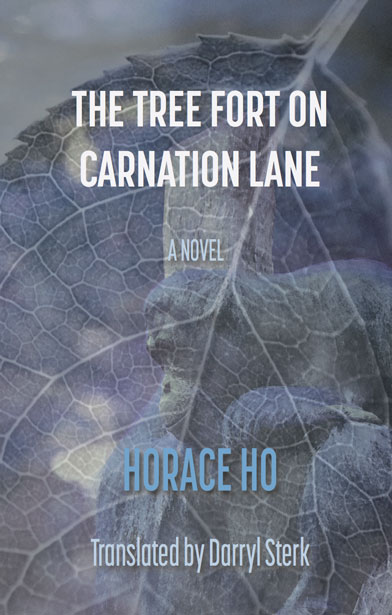The Tree Fort on Carnation Lane by Horace Ho
Translated by Darryl Sterk (Balestier Press, 2017)
Publisher's Blurb
Daniel Fang’s mid-thirties are marked by the birth of his daughter and the death of a childhood friend. His daughter’s birth and infancy reminds him of his own boyhood, his friend’s death of the good times he had with back in their old neighbou rhood.
rhood.
They were the kids from the wrong side of the temple, kids who grew up in the night market and next to the red light district. Their parents didn’t like them visiting the market by themselves and expressly forbade them from taking a single step into Carnation Lane. But the appearance of a chained orangutan in a night market spectacle the year the three friends turned twelve convinced them to defy the parental ban. While the adults were away at a protest against the Martial Law, they stole into the banned zone, released the beast from bondage and led it upstream, on a quest to find the fabled zoo.
The memory of this all-but-forgotten childhood experience comes back after news of his friend’s suicide. It seems to Daniel Fang that the two events must somehow be connected. A cryptologist by training, he decides to investigate, hoping to solve the mystery of his friend’s death and decode the message contained within the memory that has shaped, even warped, their later lives.
Reading Chinese Network Reviews
Reviewed by Catherine Shipley, 24/11/17
 The Tree Fort on Carnation Lane takes us on a journey of reminiscence, allowing us to experience not only special moments in the life of the narrator but also unique times in Taiwanese history, which form a backdrop to the narrator’s personal story. Daniel, the narrator, is forced to reflect on his past after receiving news of the suicide of a close childhood friend, Ilya. Daniel is a stay-at-home Dad and during the time spent looking after his two-year old daughter he can’t help but let his mind wander to his childhood days and to those of his friends.
The Tree Fort on Carnation Lane takes us on a journey of reminiscence, allowing us to experience not only special moments in the life of the narrator but also unique times in Taiwanese history, which form a backdrop to the narrator’s personal story. Daniel, the narrator, is forced to reflect on his past after receiving news of the suicide of a close childhood friend, Ilya. Daniel is a stay-at-home Dad and during the time spent looking after his two-year old daughter he can’t help but let his mind wander to his childhood days and to those of his friends.
As with most reflections on the past we get the impression that Danny is looking for clues as to what may have led to the way each friend’s life has turned out today. He may be searching for a turning point that led them each in a different direction and, in particular, caused such a tragic end to Ilya’s life.
Despite the poverty that most of the boys grew up in, their childhood days are colourful and varied in comparison to the starkness of adulthood. Regardless of the strict regulations, beatings and even alcoholism of their parents, the boys led adventurous lives in which the world appeared to be a place of mystery waiting to be explored. Breaking some of the rules enforced on them by parents led to feelings of exhilaration that would be harder to find as they grew older and such rules faded away.
Readers are treated to descriptions that bring to life a run-down night market neighbourhood in East Taipei. We can vividly picture the scenes described, which form stories of their own within the broader narrative. One such story tells of twin sisters, whose development was stunted, leading to them being unusually small and thin. As their father lay drunkenly in the alley each day they lovingly washed and prepared guavas to sell on their night market cart. They would struggle to push the cart through the alley, working together to heave it over tricky parts of the street.
There is a dream-like quality to the childhood stories. Daniel admits himself that, as many years have passed, it can be challenging to identify the truth in memories. Memories are embellished or fade away. They are influenced by emotions and by the more recent past. We feel that Daniel is also looking for affirmation of his current life through going back through experiences in his past. It is possible that he would like to know whether he has made the right decision by devoting all his time to his little daughter, especially as he senses suppressed disapproval from his wife.
As readers, we are privileged to share in the intimate personal history of the narrator, his friends and his neighbours. We enjoy the fun and mischief, although we also experience the sense of sadness and loss that accompanies such memories.
Reviewed by Catherine Shipley.
Reviewed by Yue Xin, 13/9/17
 Horace Ho’s newly published bildungsroman is about three boys: Daniel, Brand and Ilya, who were born in the same neighbourhood near a red light district in Taiwan during the 1970s and 1980s. Told through the lens of Daniel as the narrator, who is already in his mid-thirties, we travel between past and present, puberty and maturity, tradition and taboo, upscale residence and slum, life and death…trying to decrypt the reasons behind the shocking suicide of Ilya. He intertwines and compares the memories and feelings of himself as a little boy with his present daily life with his daughter and wife, to make the retrospective narrations of Taiwan more vivid and impressive. However, the book also implicitly reveals its political meaning and can be valued as an exploration of self and national identity. It seems to me that it is the combination of strict social-political atmosphere, gruelling family education and dim light of freedom that together caused the eventual tragedy.
Horace Ho’s newly published bildungsroman is about three boys: Daniel, Brand and Ilya, who were born in the same neighbourhood near a red light district in Taiwan during the 1970s and 1980s. Told through the lens of Daniel as the narrator, who is already in his mid-thirties, we travel between past and present, puberty and maturity, tradition and taboo, upscale residence and slum, life and death…trying to decrypt the reasons behind the shocking suicide of Ilya. He intertwines and compares the memories and feelings of himself as a little boy with his present daily life with his daughter and wife, to make the retrospective narrations of Taiwan more vivid and impressive. However, the book also implicitly reveals its political meaning and can be valued as an exploration of self and national identity. It seems to me that it is the combination of strict social-political atmosphere, gruelling family education and dim light of freedom that together caused the eventual tragedy.
The year 1987 marks a watershed when Taiwan finally ended the four-decade martial law which had banned formation of any new political parties, imposed wide political censorship and given full authoritarian rights to the KMT government. It is implied in the novel that the boyhood stories are set during the ambiguous time around this period, before the turning point of history when many dangwai (non-party) activities emerged as components of a fledgling democracy. However, the watershed moment was never clear-cut and its shadow still remains as an obstacle for the gradual democratic transition.
Just like what Taiwan was experiencing at that time, Brand’s father completed his own transition from a troupe leader to a congressman through emulating the “revolutionary” Sun Yet-sen, leading demonstrations at the temple, publishing propaganda pamphlets and slogans. The transformation of a stiff and suffocated society began at this time. A symbolic incident that is highlighted in the novel is the rescue of a orangutan. The orangutan, who was sick, trapped in chains and forced to perform every night, moved the boys’ hearts, especially Ilya’s. Thus, they decided to rescue it and take it to the zoo, despite the fact that none of them had ever been there.
The difficulties they encountered during the rescue symbolize the struggle for freedom, overcoming obstacles both in their individual lives and society as a whole. Ilya persists in heading forwards in the darkness, despite not knowing a way back. His companions Daniel and Brand were more laid-back, playing around on the river bank without much to worry about, and this indicates the different fates of the three boyhood friends. But no matter how carefree their childhood could be, they could never get rid of the socio-political currents. But life deals them a sharp blow overnight and teaches them some lessons in maturity. The tree fort the three built together as the solid shelter and the emblem of their friendship was torn down in the end.
A recurrent recollection of Daniel throughout the book is that at three years old he was forced to kneel before the family altar under suspicion of stealing a hundred-dollar bill, with the reddish glow of two electric candles reflected on everyone’s faces in the room. He kept rewinding this shameful story every time he was worried about getting punished for disobedience. While Ilya endured a stricter family education conducted by his single mother, a widow who put all her hope on her only son, with full-time academic and piano lessons. There was no chance for Ilya to fail. Although he eventually achieved the labelled success in most Asian parents’ eyes as a pianist who studied and lived abroad, he was merely a giant baby who could not live without his mother.
Brand displays intelligence beyond his years when he claims “everyone should decide his own fate, that you can’t let other people make your choices or live your life for you.” He was the one who had the freest education because of his rebellious father, his lack of a mother figure, and a comfortable financial background. While traditionally, in Confucian ideology, obedience and obligation are closely linked with filial piety, ingrained in the family structure, reading Ilya’s stories therefore recall the harsh Asian educational system described in Amy Chua's best-selling Battle Hymn of the Tiger Mother. Coincidentally or not, in this novel, all the mother characters display such stereotyped tendencies of ferocious tempers and stringent demands on their children.
Children’s curiosity and nature can never be suppressed. In Ilya one can see the conflicts coexisting ridiculously: he’s the most obedient one but also rebellious enough to be the first to stay overnight in the tree fort; he was timid as the smallest one while also brave enough to befriend and take care of the orangutan; he is a mature kid but also a vulnerable adult. As the typical outcome of the Asian education system, Ilya’s tragedy is never simply an individual case.
“Freedom is worth any amount of suffering,” Brand declared when the boys were urging the orangutan to get into their handmade sugarcane cart so that they could carry it to the Watergate. But the problem remains, what if you still don’t get the freedom even if you’ve paid the price of life? What if you still failed even if you tried hard? Is freedom still worth pursuing?
With the assistance of translator Darryl Sterk, the open ending of the orangutan rescue becomes extremely breath-taking. However, no matter how hard Daniel attempted to decrypt the present by picking up the pieces of past, their neighbourhood near Carnation Lane would never come back, nor would the Tree Fort.
Reviewed by Yue Xin
Reviewed by Zahra Raja, 5/7/17
 This is the first book I’ve read for many years that wasn’t in a recommended list for a module at university, and I was keen to read something that was stimulating but would not ask too much of my poor, overworked brain. The Tree Fort on Carnation Lane was perfect for this purpose. Daniel Fang is an unemployed professor of cryptology and is also a stay-at-home dad for his young daughter. After receiving the news of his childhood friend’s suicide, he is thrust back into memories of his childhood in the night market; in particular, the events leading up to the freeing of a chained orang-utan forced to perform in a night market show and their desperate bid to deliver it to a fabled zoo. Daniel is convinced that these events and his friend’s suicide are connected, and thus decides to attempt to decrypt the code of his memories, hoping to solve the mystery of his friend’s death.
This is the first book I’ve read for many years that wasn’t in a recommended list for a module at university, and I was keen to read something that was stimulating but would not ask too much of my poor, overworked brain. The Tree Fort on Carnation Lane was perfect for this purpose. Daniel Fang is an unemployed professor of cryptology and is also a stay-at-home dad for his young daughter. After receiving the news of his childhood friend’s suicide, he is thrust back into memories of his childhood in the night market; in particular, the events leading up to the freeing of a chained orang-utan forced to perform in a night market show and their desperate bid to deliver it to a fabled zoo. Daniel is convinced that these events and his friend’s suicide are connected, and thus decides to attempt to decrypt the code of his memories, hoping to solve the mystery of his friend’s death.
What I most enjoyed about this book was how the author decided to use a non-linear narrative; each chapter flashes between different past memories and the present time, which allows us to witness Daniel’s own analysis of his memories and the lead-up to Ilya’s suicide. The turning point, in Daniel’s mind, is the failure of their quest to free the orang-utan. The quest and the events leading up to it is the first and last time we see Ilya rebel against his overbearing mother, and it is implied in the book that she may have been partially to blame for the suicide of her husband. Once the quest fails, Ilya’s rebellious spark too disappears and he submits to his mother’s wishes to pursue a career in music.
When Daniel reaches the limit of the memories he has of Ilya at the end of the book, he is not content with his final decryption, and decides to revisit them again from a different perspective to see if any new information can be gleaned. Undoubtedly, this is his way of dealing with his grief; whether or not he will ever come to terms with Ilya’s suicide is questionable due to the novel’s circular conclusion.
This novel will appeal to a broad audience, as it is not an overly difficult read but provides enough challenge to be interesting in its plot and structure. The author has an excellent command of language which is skilfully translated into English, and the scene is painted in a way that doesn’t feel tired or clichéd, which when combined with a well thought out story made for novel that I couldn’t put down. I will be checking out his other works!
Reviewed by Zahra Raja
